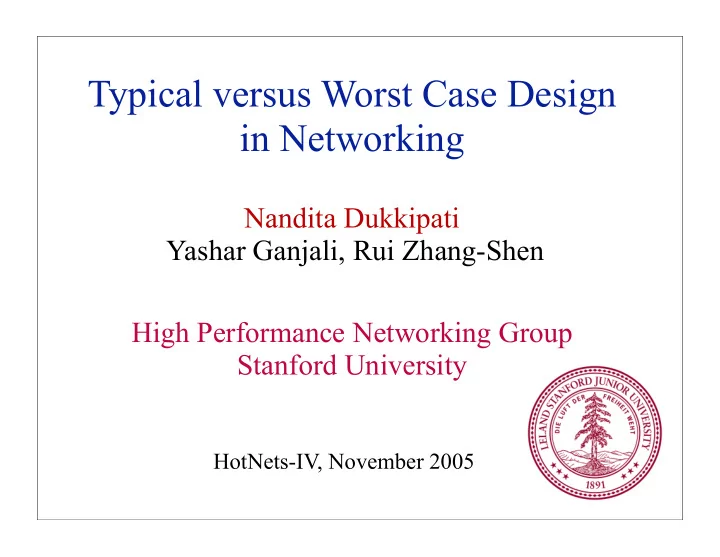

Typical versus Worst Case Design in Networking Nandita Dukkipati Yashar Ganjali, Rui Zhang-Shen High Performance Networking Group Stanford University HotNets-IV, November 2005
Introduction: Worst-case design • Preference for worst-case design: packet classification algorithms, switch buffer architectures, congestion control, ... • Lampson’s hint: “... Normal case must be fast. The worst- case must make some progress. ” • Why the preference for worst-case design? • Typical case known only after system is deployed • Easier to quantify/verify/prove performance • Feels good and safe
Introduction: The case for typical-case design • Worst-case design does not always make sense • Our position: Design for the typical-case unless designing for the worst-case is absolutely necessary or cheap • Examples: • Buffer sizing in core routers • Designing a congestion control algorithm • Backbone network design
Typical-case Design: Buffer Sizing for Core Routers • How much buffering do Internet routers need to guarantee near 100% link utilization ? • Rule of thumb: C × RTT • Example: RTT = 250 ms, C = 40 Gbps, buffer size = 1,250,000 packets • Rule of thumb holds for single/synchronized flow(s) Congestion Window RTTxC + B Size RTTxC Packet drop Time Queue Size B Time
Typical-case Design: Small Buffers • Desynchronized flows: expect less buffering Congestion Window Size Time C × RTT • Buffering needed: √ N • Example: RTT = 250 ms, C = 40 Gbps, N = 10000, buffer size = 12,500 packets • Worst-case: few flows, Typical-case: thousands of flows • Benefits: reduced delay and jitter, simplified router architecture
Typical-case Design: Very Small Buffers • Worst-case assumption: core link should be 100% utilized • Recent work: Buffer size 10-20 packets, link utilization 75% • Five orders magnitude reduction from original rule-of-thumb • Consequences: all-optical routers, very high capacity network, low power consumption, low delay...
Typical-case Design: Designing Congestion Control • Congestion control is deliberately designed to be conservative • Starts flows slowly: helps in flash crowd scenarios • Works well when most or all flows are long-lived mean flow size >= “pipe” size • Typical case: mean flow size << “pipe” size
Typical-case Design: Designing Congestion Control Flow Duration (secs) vs. Flow Size • Flows arrive in a Poisson process and have a heavy- tailed flow-size distribution • Consequence: Makes flows last many times longer than necessary in the typical case
Typical-case Design: Rate Control Protocol (RCP) • Rate Control Protocol (RCP): Designed for fast Flow Completion times --- close to ideal processor sharing d 0 ( α ( C − y ( t )) − β q ( t ) T d 0 ) R ( t ) = R ( t − T )[1 + ] C Typical case: One/two orders of magnitude reduction in Flow Completion Time Worst case: Flash crowds
When Worst-case Design makes sense • Worst-case guarantees are required • Cheap to design for worst case and it doesn’t overly hurt the typical case • Don’t know the typical-case or it is likely to change faster than you expect to change your design
Worst-case Design: Backbone Network Design • What makes network design hard ? • Inaccurate design input • No guarantees on handling deviant matrices • Need to provision for failures • Example: � � T = { Λ | λ ij ≤ R i , ∀ i ; λ ji ≤ R i , ∀ i } j j 4 1 % over-provision % traffic-matrices 0% 0.20% 25% 2.59% 3 2 50% 15.09%
Worst-case Design:Valiant Load Balancing 2 r/N r 1 2 r 3 N … 4 r r
Worst-case Design: VLB Characteristics • Worst-case guarantees • Can support all feasible traffic-matrices • Is provably the most efficient in supporting all traffic • Empirical study: About the same cost as conventional network • Typical-case: • Max. propagation delay bounded by 2x network diameter • Only load-balance when necessary • There are “express paths”
Conclusion • Blindly designing for worst-case does not make sense • Immense benefits in typical-case design in terms of performance, cost and complexity • Design for typical-case unless typical-case is not known or the worst-case design is absolutely necessary or is cheap.
Recommend
More recommend